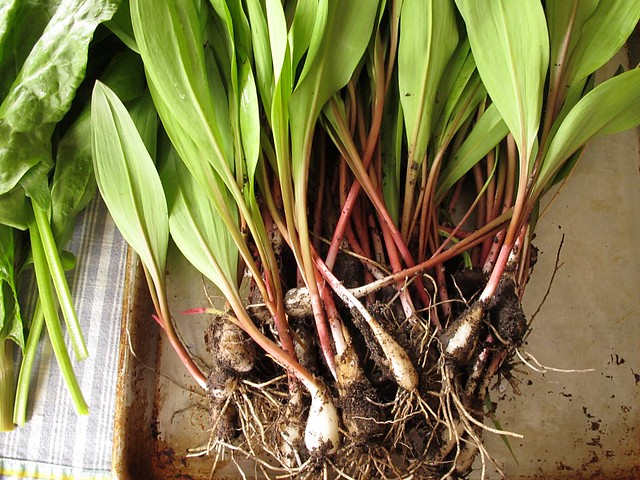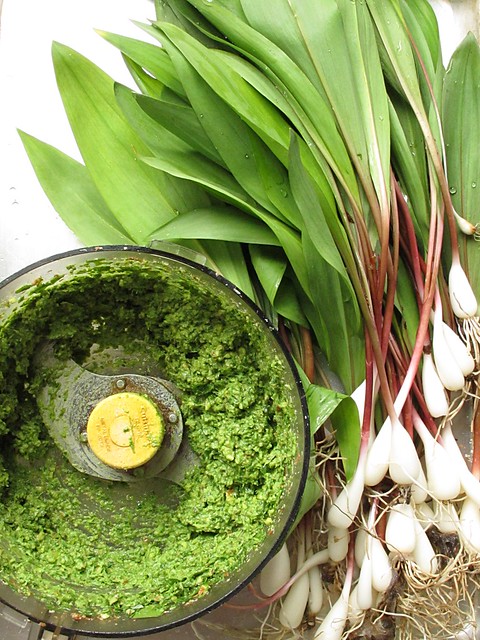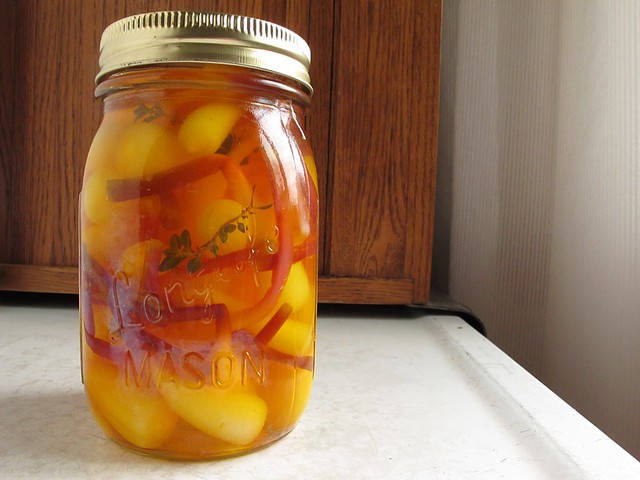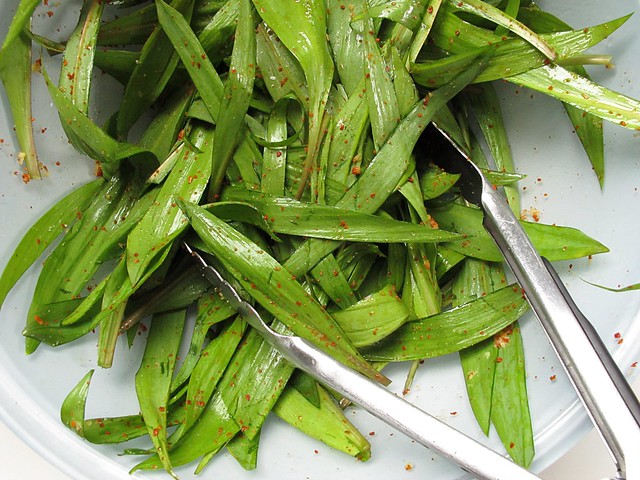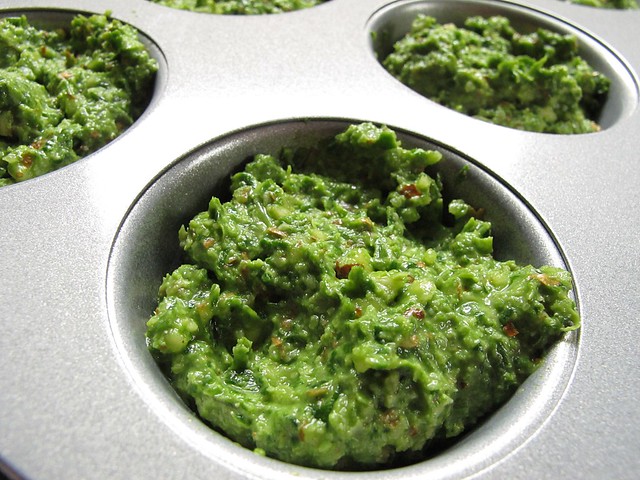Well, a whole week has passed without a single word from rcakewalk. The truth is, I had a lovely Summer Cold most of last week, and really didn't do much cooking until I needed to get ready for the Boy-O's birthday on Friday. I feel like I have a lot of time to make up for, since being compromised in taste and smell faculties rendered me a pretty poor kitchen experimenter for many days. (Though, I did manage to read all the way through Wild Fermentation - and start a "ginger bug", and then after the bug was going, I bottled a little batch of ginger beer.)
Last night, I knew that I was feeling better, when I was automatically planning what I could come up with for my continuing Vegan Monday postings. Since my basil was in need of pinching back again, I figured pasta and pesto would be a good choice for supper... and it was a happily sneaky one that my Husband ate without knowledge of its delicious vegan-ness.

I really love making pasta from scratch. I've done it now for probably 12 years, and can't say that I've ever tried to make it without eggs. What's even worse, is that
I wrote a post about beet pasta, in which I tweaked a recipe I saw in the
Outpost Exchange that did not contain eggs, and I actually said that I prefer pasta that does. I can now attest that this is because I never had homemade semolina pasta. It is wonderful, and easy to do, and I may just have to take back the song previously sung about the wonders of egg pasta.

Semolina flour, in it's sand-like peskyness, is very high in gluten - which enables it to stretch and not break when cooking. I noticed the difference immediately when working with the dough. It was a resisting, silky thing; when rolled thinly (notch 6 on my Atlas Pasta Queen), it felt as if I were feeding a sheet of peached cotton through the cutters. The strands of finished fettuccine did not stick together either, and I could see myself actually able to roll little nests like Marcella Hazan without much difficulty. The dried pasta (seen in the first photo, above), did not break or crack when I moved it to a sheet pan. I was excited, since already I could tell that I was going to be so happy with the cooked result.

This morning, I mixed up a small batch using proportions from
A Life(time) of Cooking. I needed almost twice the amount of water she recommended, but went by the feel of my egg pasta past, and was indeed rewarded with the pretty little dough seen above. Then, Boy-O (now a proud 4 year old!) and I went for a walk. As I like to err on the side of gluttony (a phrase coined by my Husband and Maeckel), I decided I had to make a second little batch, only whilst walking, I figured there was no reason not to try it with wheat flour and semolina.
Since the recipe calls for equal proportion of all purpose flour and semolina flour, I'm imagining all kinds of whole grain flour combinations are going to be tried sometime in the future. I used a
white whole wheat flour from King Arthur Flour. The dough was just as nice to work with, and cooked up into a mildly, wheat flavored pasta. I heard no complaints from either of my guys, so I'm taking it that they couldn't even tell. I think the truth of the matter is that homemade pasta so far surpasses store bought pasta, that you would be hard pressed to find someone who thought otherwise.

The base recipe suggests that for each generous serving, these are the proportions to use. When I had two batches (using different flours), the total weight was just shy of 1 lb... The best thing about homemade pasta, is that it does store well. Just make sure it's dried well first, and then seal it in a zip top bag. It's even more of a convenience food than it's supermarketed brethren, since it takes mere minutes to cook. Even more reason for you to give it a go!
(Vegan) Semolina Pasta (adapted from
A Life(time) of Cooking)
- 1/2 c. semolina flour
- 1/2 c. AP flour (or white whole wheat - I used KAF)
- pinch of salt
- 1 t. olive oil (eyeball it)
- 6-8 T. water, to feel
In a medium sized bowl, mix the flours and salt. Add the olive oil, then 4 T. of the water, while stirring the forming dough with your fingers. Add enough water to get the dough to form into a ball. (The semolina flour, and the wheat flour, will soak up a bit more liquid than regular AP flour.) When the dough is formed into a ball, knead gently for a few strokes on a wooden board to be sure everything is incorporated well.
Let the dough rest for at least a half hour. Roll out either by hand on a well floured board, or by hand cranked or stand mixer attachment, using regular AP flour as necessary. Cut into desired shape, and let dry (or cook right away).
When cooking, bring an ample amount of salted water to boil and add the pasta. Watch it carefully, it takes just a few minutes to cook. I start testing it when I see it boil up to the surface, usually around the three minute mark.
 Semolina/AP flour pasta on the left, semolina/white whole wheat pasta on the right.
Semolina/AP flour pasta on the left, semolina/white whole wheat pasta on the right.Of course, since I went through the trouble of making eggless pasta, I made a vegan pesto as well - from another winning recipe from Dreena Burton's Eat Drink & Be Vegan. I found
the recipe printed for you here, from an interview that Dreena did for Vegan Freak Radio, and let me tell you - you may never find yourself buying a pine nut ever again. It was so creamy, fresh, and when I first tasted it, the bite of raw garlic perfectly complemented the other ingredients. (The only thing I did differently, other than not really measuring anything, was to omit the dried mustard. Why oh why do I always remember that I don't have this spice stocked until the last second? The amount needed was too little to be processed out of mustard seeds in my coffee mill/spice mill... so I just left it out.) I'm looking forward to having some of the leftovers on a pizza tomorrow...

While the final dish left something photographically to be desired, the taste did not. The pasta had perfect bite, just a tad more toothsomeness in the whole wheat version, and because I remembered to save some of the pasta's cooking water, I had a nicely thickened pesto sauce that gently coated the noodles. You could go all out and load up on the sauce,
like Dreena does, but I have hopes for my leftovers tomorrow, so I restrained.

I'm sure I'll be back to my cooking self this week, and already I'm behind on my weekly fermenting/culturing duties. I actually have to start my next kombucha batch now before I hit the hay...
But before I do go: A non-vegan bit of information I must pass on! I got the best tip ever from my reading of
Wild Fermentation for all of you yogurt makers out there: for every quart of milk you are inoculating with the yogurt culture from a previous batch, only use 1 Tablespoon of culture. 1 Tablespoon! I always use much more, but thanks to Sandor (and The Joy of Cooking) - who explained that less culture gives the bacillus room to move and creates a thicker, creamier result. I did this today, and in just 7 hours had beautifully thickened yogurt, with no separation!
So how is THAT to end a Vegan Monday post! From what I've read, you can make a soy or alternative milk yogurt from a culture, but the culture will not perpetuate. Also, I do not believe that the cultures can be dairy free to start... so now I'm curious, and have some label reading to do on my next Outpost trip. Maybe I know what direction I'm heading for next week's vegan post...
